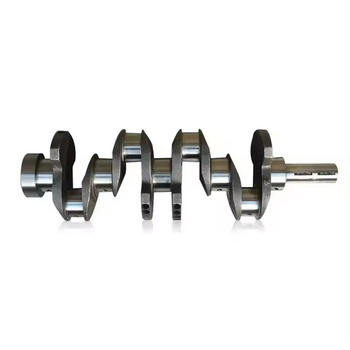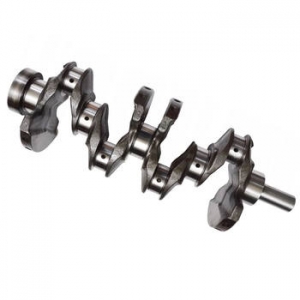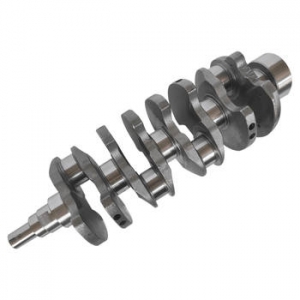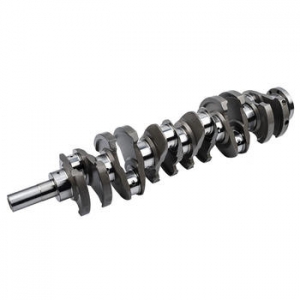Unlocking Power: A Deep Dive into Custom Crankshaft Design Specifications
Views :
Update time : 2025-06-15
Have you ever wondered what truly sets a high-performance engine apart from its standard counterpart? Often, the secret lies deep within its core, specifically in components engineered for extreme precision and durability. Frankly speaking, when we talk about pushing the boundaries of power, efficiency, and reliability, the crankshaft is undeniably a star player. And for those truly specialized applications—be it racing, aerospace, or heavy-duty industrial machinery—standard off-the-shelf solutions simply won't cut it. This is where the meticulous world of custom crankshaft design specifications comes into play.
To be honest, designing a custom crankshaft is far more than just scaling up or down an existing model. It's an intricate dance between physics, material science, and precision engineering, tailored to meet the unique demands of a specific engine and its operational environment. Every single parameter, from stroke length to journal diameter, counterweight mass, and even surface finish, is carefully considered and optimized. In my experience, overlooking even the smallest detail in these specifications can lead to catastrophic failure or, at best, a significant compromise in performance.
The Foundation: Understanding Custom Crankshaft Design Specifications
When embarking on a project that requires a custom crankshaft, the very first step is a thorough understanding of the engine's intended application and performance goals. This initial phase is critical because it directly informs every single aspect of the custom crankshaft design specifications. We're talking about everything from peak RPMs and combustion pressures to the desired power output and the overall engine package constraints. Interestingly enough, it's not just about raw power; durability, vibration characteristics, and even weight reduction are equally vital considerations.Load Analysis and Stress Points
A custom crankshaft must withstand immense forces. Think about it: during operation, the crankshaft is subjected to cyclical bending, torsional, and shear stresses. These forces originate from the combustion process, the inertia of the reciprocating components (pistons, connecting rods), and the rotational dynamics of the crankshaft itself. Therefore, a comprehensive load analysis is paramount. Engineers use sophisticated Finite Element Analysis (FEA) software to simulate these forces and identify potential stress concentration points. This allows them to optimize the geometry, such as fillet radii between journals and webs, to distribute stress more evenly and prevent fatigue failure. I've found that paying close attention to these high-stress areas during the design phase can significantly extend the lifespan of the component.Balancing and Vibration Control
Another crucial element in bespoke crankshaft engineering is achieving perfect balance. An unbalanced crankshaft can lead to excessive vibrations, which not only cause discomfort but can also lead to premature wear of bearings, engine mounts, and even structural damage to the engine block itself. Both static and dynamic balancing are performed. Static balance ensures that the weight is evenly distributed around the axis of rotation, while dynamic balance addresses any wobbling motion that might occur during rotation. This often involves carefully calculating and integrating counterweights into the crankshaft design. These counterweights offset the inertial forces of the pistons and connecting rods, ensuring smooth operation even at very high RPMs. Many experts agree that precise balancing is a hallmark of a truly high-quality custom crankshaft.
Material Science: The Heart of Durability and Performance
The choice of material is arguably one of the most critical decisions in defining custom crankshaft design specifications. The material must possess an exceptional combination of strength, toughness, fatigue resistance, and machinability. Frankly speaking, a crankshaft operates in an incredibly harsh environment, constantly subjected to high temperatures, immense pressures, and cyclical loading.Forging vs. Billet Machining
Traditionally, crankshafts have been forged. Forging involves heating a steel blank and shaping it under immense pressure, which aligns the grain structure of the metal with the shape of the part. This process enhances the material's strength and fatigue resistance, making forged crankshafts incredibly robust. Common materials for forging include 4340 steel, EN40B, and various proprietary alloys. However, for truly custom, low-volume, or highly specialized applications, billet machining has become increasingly popular. Billet crankshafts are machined from a solid block of high-grade steel. While they don't inherently benefit from the grain flow advantages of forging, the ability to machine complex geometries with extreme precision, coupled with the use of premium, often vacuum-melted, steel alloys, makes them a top choice for elite performance. This method offers greater flexibility in design, allowing for unique counterweight shapes, lighter designs, and more intricate oiling passages. It's worth noting that the quality of the raw billet material and the precision of the machining process are paramount here.Surface Treatment and Hardening
Beyond the base material, surface treatments play a vital role in enhancing the durability and longevity of custom crankshafts. Nitriding is a common process where nitrogen is diffused into the surface of the steel, creating a hardened layer that significantly improves wear resistance and fatigue strength. Shot peening, another widely used technique, involves bombarding the surface with small, spherical media. This creates compressive residual stresses on the surface, which helps to resist the initiation and propagation of fatigue cracks. These crankshaft material selection guidelines are not just theoretical; they are proven strategies for extending the life of high-performance engine components. In my experience, neglecting these treatments is a costly oversight.Precision Engineering: Manufacturing and Machining Excellence
Once the custom crankshaft design specifications are finalized and the material selected, the manufacturing process begins. This is where the theoretical design transforms into a tangible, high-precision component. The journey from raw material to finished crankshaft is a testament to modern manufacturing capabilities and the skill of experienced machinists. Modern custom crankshaft manufacturing heavily relies on advanced CAD (Computer-Aided Design) and CAM (Computer-Aided Manufacturing) software. The 3D models created during the design phase are directly translated into machine code, guiding multi-axis CNC (Computer Numerical Control) machines. These machines can perform complex operations like turning, milling, and grinding with incredible accuracy, often holding tolerances down to a few microns. The machining sequence is critical. It typically starts with roughing operations to remove the bulk of the material, followed by semi-finishing, and finally, precision grinding and polishing. Each journal and fillet radius must be machined to exact specifications to ensure proper bearing fitment and optimal stress distribution. The oiling holes, which are vital for lubrication, are also precisely drilled and deburred.
Validation and Quality Assurance: Ensuring Peak Performance
The journey of a custom crankshaft doesn't end with manufacturing. Before it ever sees the inside of an engine, it must undergo a rigorous battery of tests and quality assurance checks. This phase is absolutely non-negotiable, ensuring that every single aspect of the custom crankshaft design specifications has been met and that the component will perform reliably under extreme conditions.Rigorous Testing Methodologies
Testing begins with non-destructive testing (NDT) methods. Magnetic Particle Inspection (MPI) is commonly used to detect surface and near-surface cracks, while ultrasonic testing can reveal internal flaws or voids within the material. These tests are vital for catching any imperfections that might have arisen during material processing or manufacturing. Dimensional inspection is another critical step. Using highly accurate metrology equipment, every dimension of the crankshaft—journal diameters, stroke, pin locations, fillet radii, and overall length—is meticulously measured and compared against the design specifications. Any deviation, no matter how small, can impact performance or lead to premature failure. Beyond these static checks, custom crankshafts, especially those for very demanding applications, often undergo fatigue testing. This involves subjecting the crankshaft to cyclical loads that simulate real-world engine operation, often at stress levels exceeding typical conditions. The goal is to determine the crankshaft's endurance limit and identify potential weak points before it's ever installed in an engine. Sometimes, even dyno testing of the complete engine assembly with the custom crankshaft is performed to validate its real-world performance and durability.The Role of Metrology
The precision required in custom crankshaft manufacturing demands equally precise measurement tools. Coordinate Measuring Machines (CMMs) are often employed to verify complex geometries and tight tolerances. These machines use probes to touch thousands of points on the crankshaft's surface, creating a highly accurate 3D map that is then compared to the original CAD model. This level of metrology ensures that the finished product precisely matches the engineered design, leaving no room for error. In my experience, a robust quality control system, from raw material inspection to final product validation, is what truly differentiates a superior custom crankshaft.The Future and Final Thoughts on Custom Crankshafts
The world of engine technology is constantly evolving, and with it, the demands placed on components like the crankshaft. Looking ahead, what advancements do you foresee in this critical field? We're already seeing increasing interest in advanced materials, such as those with improved strength-to-weight ratios, and even exploring additive manufacturing (3D printing) for complex internal structures, though this is still largely in the research phase for such high-stress components. The drive for lighter, stronger, and more efficient engines will continue to push the boundaries of custom crankshaft design specifications. One thing is clear: the need for specialized, high-performance engine components will never diminish. Whether it's for a record-breaking race car, a next-generation aerospace engine, or a critical industrial power unit, the ability to precisely engineer a crankshaft to meet exact performance parameters remains invaluable. The intricate process, from initial concept and detailed load analysis to material selection, precision machining, and rigorous testing, underscores why custom crankshafts are truly at the heart of engineering excellence. They are not just parts; they are carefully crafted solutions designed to unlock the full potential of any specialized engine. The expertise involved in this field ensures that power, reliability, and innovation continue to drive forward.For more detailed information, please visit our official website:custom crankshaft design specifications
About the author: Dr. Elias Thorne is a renowned expert in advanced mechanical engineering with over two decades of experience specializing in high-performance engine components. His work focuses on material science, stress analysis, and precision manufacturing techniques for critical rotating assemblies. Dr. Thorne has consulted for leading automotive and aerospace firms, contributing to the development of groundbreaking custom crankshaft designs that push the limits of power and durability.
Related News
Read More >>
 The Ultimate Guide to Getting
The Ultimate Guide to Getting
06 .15.2025
Unlock accurate crankshaft price quotes. Learn factors influencing cost, where to buy, and whether t...
 The Unsung Heroes: Unveiling t
The Unsung Heroes: Unveiling t
06 .15.2025
Explore the critical role of a crankshaft manufacturer in powering industries. Discover the precisio...
 Unlocking Power: A Deep Dive i
Unlocking Power: A Deep Dive i
06 .15.2025
Explore the intricate world of custom crankshaft design specifications. Learn about materials, manuf...
 The Ultimate Industrial Cranks
The Ultimate Industrial Cranks
06 .15.2025
Unlock peak performance with our industrial crankshaft material selection guide. Learn about steel, ...
